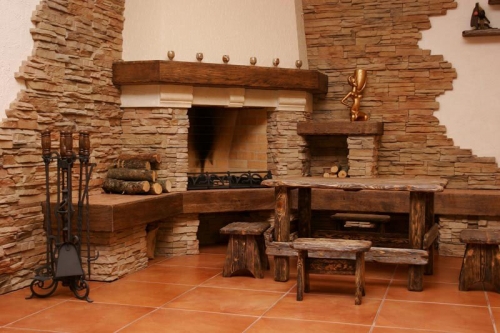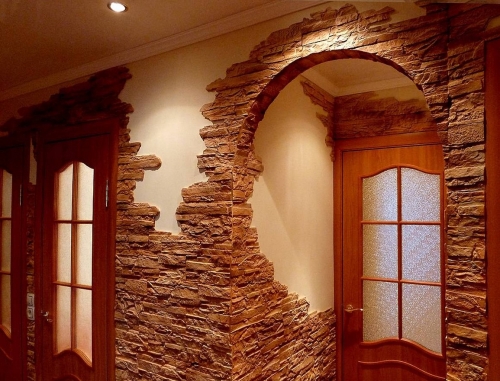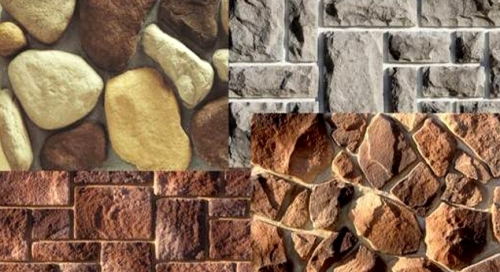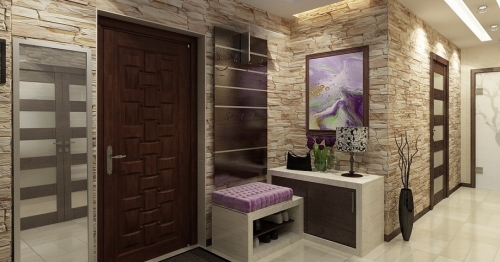Despite the abundance of materials and the so -called paradise, the market is not ...
|
|
Modern cottage or country house is unthinkable without familiar amenities ... |
In snow winters, no construction can do without such protective structures as ... |
DIY decorative stone laying

The maximum sophistication, chic and originality is able to add both to the interior and to the exterior decorative stone. It combines an aesthetic appearance and excellent performance.
But, in order for the decorative element of the interior to serve as long as possible, while maintaining an excellent view, you need to know important rules and some nuances of laying stone. About this further in the article.
Table of contents
- Decorative stone exquisite interior element
- The advantages of decorative stone
- Types of decorative stone
- Preparatory work
- Decorative stone styling technology
- Finish
- Errors when laying decorative stone
Decorative stone exquisite interior element
Decorative stone looks great in the decoration of fireplaces, door and window openings. It also perfectly combines with a variety of ways of organizing aquariums and fountains, as well as indoor plants. Of course, at the mention of stone walls, the living room with a fireplace and with furniture in a classic style immediately comes to mind.
If you decide to add notes of chic and aristocracy to your interior, having designed the entire wall or a separate part with a decorative stone, then you should remember about its important feature. To illuminate such a room, much more light will be required, since with insufficient lighting, the finish will seem too gloomy. However, this problem will solve this problem by alternating decorative stone and light plain wallpaper, paints or plaster.
The advantages of decorative stone
Firstly, a decorative stone in your interior will become a wonderful highlight that guests will immediately pay attention to.
Secondly, it is very easy to work with it, thanks to easy weight and correct forms. In addition, the stone does not need special care, any detergent will be enough.
Thirdly, decorative stone is an environmentally friendly material, it is resistant to corrosion, fungal and other bacteria.
Fourthly, it is very reliable, therefore, to serve you for many years, while maintaining all your qualities
Fifthly, a wide selection of colors, structure and style of execution allows you to create an interior that fully satisfies all your desires and needs.
Types of decorative stone
The most common are decorative stones based on:
- cement mortar;
- gypsum.
Decorative gypsum stones are not able to withstand high humidity, so they are usually used in rooms with low humidity, for example, in the bedroom, corridor or living room. Decorative stones made of cement mortar, on the contrary, are moisture resistant, so that they can be used in the bathroom, in the kitchen, etc.
To date, artificial decorative stones imitating brick and slate have been widely used widely used.
The brick fits perfectly into the interior of the balcony, bedrooms and corridor, is able to create both strict and fashionable design of the room.
Glutz is the only type of decorative stone that creates a continuous stone surface. Each element of shale has a bright personality and composition of such a stone looks very impressive and enchanting.
Among natural decorative stones, sandstone, limestone, marble, granite are very popular.
The color palette of marble is very wide, brown, black, red, beige and, of course, white colors are considered the most popular. Even the most picky person will not remain indifferent to such a decorative stone.
The sandstone is large, medium and fine-grained, its color palette consists of three shades: red, green and chocolate. The layout of its laying is simple - the stones of sandstone are laid in the type of mosaic pattern, uniform alternation of horizontal and vertical elements.
Limestone is an alloy of stone of various sizes laid in a horizontal row. It can be with a yellowish, white, gray and pink tint.
Preparatory work
Before starting the installation of decorative stone, it is important to carefully prepare the surface. To begin with, you should remove the remains of old wallpaper, paint, spots, fats, etc.. A perfectly flat surface can not be achieved, since the stone will hide all flaws. It is more important to check the surface adhesion. Sprinkle the wall with water and pay attention to those areas where the water is not absorbed, but forms drops (if they are, of course). These places should be thoroughly mechanically processed, then again check the surface for sticking.
Further, it is recommended to scratch the wall with a metal brush for better adhesion of the glue, then treat the surface and the back of the stone with a water -based primer with a painting hand.
Before starting laying facing stone, put the future drawing on a flat surface, this will help you see how the composition will look on the wall, eliminate confusion and ridiculous drawings in the process of work.
Decorative stone styling technology
General rules
In order to lay a decorative stone with your own hands, it is not necessary to have a design education, it will be enough to trust in its intuition and imagination, the rest will be complemented by the finishing material itself.
Installation of finishing stone should be carried out at a temperature of +5 C to + 30 C. If the temperature is higher, then 25-30 minutes before the start of work should be moistened with the surface and back of the stone with water.
Before the start of laying, inspect the decorative stone, very often its shade depends on the side of the inspection. Better ask the manufacturer which side to lay out it.
First, it is necessary to mark on the wall with a step of less than fifty centimeters in order to have an idea of \u200b\u200bhow a stone will be placed and where to make fitting decorative elements.
The tools necessary for laying decorative stone: a construction mixer, level, spatula, bar for leveling stones, iron brush, a small brush, a bucket of water, a special brush for cleaning the seams.
For laying decorative stone, sealant or liquid nails is suitable.
It is best to start gluing tile elements from below the corner.
The most crucial part of the work is giving bizarre forms of composition. This requires fantasy, knife, pliers and sandpaper.
If you need to fit the stones in size, then use a grinding machine, a special hacksaw or pliers, then use sandpaper to bring the surface to the perfect look. It is important if there is a foamed cement base to remove it.
Tile glue should be started so that you can use the whole mass within 15-20 minutes, since after that the glue will begin to harden. The consistency of glue should be creamy, for example, such as in toothpaste. Apply a mixture of glue should be 3-4 cm thick with a gear spatula.
During laying, the stone should be pressed with relatively great power so that the excess glue comes out, but it is important to ensure that the adhesive does not fall on the front side of the stone, since it will be difficult to remove it.
Some decorative stones are not the same in size. In this case, for a more spectacular type, lay them in a chaotic manner. Remember, the decorative stone does not like rush, since the ranks can simply be sailing. This material can also be used in the street. However, styling is best done in warm times and using special glue.
Methods of laying decorative stone
Stack laying can be done with both seams and without them, it depends on personal wishes.
The seamless option for laying decorative stone is simpler and fastest.
The finishing stones should be laid out as tightly as possible, resulting in an almost monolithic surface. During work, it is important to ensure that the excess glue is removed in time, otherwise it will be difficult to do in the future.
More time -consuming is the process of laying decorative stone with stimulating seams. However, this option is the most popular, as it looks more impressive.
Stones are attached near each other at a certain distance. To make the perfect seams of the composition between the rows of stones, lay the same pieces of drywall or fiberboard not more than 1 cm wide.
After fastening all the stones and the complete drying of the glue (about 1 day) begin to put down the seams. In order to facilitate this process, putty can be filled, for example, a bag of milk and making a small hole gently squeeze the mixture exactly into the seam. Then we take a regular sponge, remove the excess putty and carefully wipe the stone.
Finish
To preserve operational properties, decorative stones should be treated with protective spray varnish, mainly it is supplied with a stone. But, before applying this protective layer, you need to carefully clean the surface of a variety of contaminants and dust. Before applying the varnish for the entire decorative composition, perform a trial processing of not used stone. If the level of shine is completely satisfied with you, then you can go to the processing of all stones on the wall. If the degree of shine is insufficient, then cover the surface with an additional layer of acrylic transparent varnish. If, on the contrary, the level of shine is too high, then dilute the varnish-consuming with ordinary water.
If you want to give greater decorativeness to your interior, then you can paint the surface of decorative stones with paint more expressive color shades.
If you conduct the decoration on your own, then the cost of laying with a decorative stone, of course, depends on the height of the stones, thickness, width and height of the elements, surface relief, type of glue and grout. If you decide to take advantage of the help of a professional, then the price of work, in addition to the above nuances, also depends on the qualifications of a specialist and on the complexity of styling.
Laying of decorative stone - Photo of ready -made compositions:
Errors when laying decorative stone
The most frequent errors when laying decorative stone:
- the seam between the stones is too wide, which spoils the overall impression of a decorative composition;
- poorly primed wall, which can lead to dumping of some stones;
- scratches, chips and other damage to decorative stone during cutting will spoil the type of cladding;
- it is not responsible to the attitude to the line of decoration will greatly ruin the appearance of the styling;
- an incorrect choice of shade and texture, decorative stone can negatively affect the entire interior of the room.
Although laying decorative stone with your own hands does not require special knowledge, however, take this process responsibly, and you will be very satisfied with the result.
Laying of decorative stone - video:














